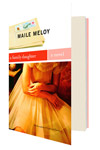
Although Liars and Saints, Maile Meloy’s first novel, was an introduction to the Santerre family, telling their story as a saga beginning in World War II and ending in present-day California, and her new novel follows the same family, this time focusing on Abby, the college-aged budding novelist, and her uncle Jamie—Meloy has not created a sequel. Instead, she reframes the same characters and situations inside an entirely new structure: A Family Daughter is a fictionalized version of Meloy’s process of writing Liars and Saints.
A Family Daughter follows Abby as she collects source material, mostly from her family’s secrets, and lays it into her own novel (e.g., Liars) with varying degrees of truth. This suggests that the story of A Family Daughter is the “real” unedited account of the Santerres, while Liars is the fictionalized version, manipulated by Abby’s imagination. It also suggests that Abby is an autobiographical character for Meloy, who, it seems, created elements of the Santerre family out of her own surrounding world. For this reason, reading A Family Daughter is like watching the author criticize her flaws and reveal her techniques.
Toward the end of the book, after her structure is carefully built, Meloy lets the novel collapse on itself. Essentially, her old novel attacks her new novel. When Abby publishes her book, the Santerres (her mother, her aunt, etc.) reject their fictionalized personas and struggle to remember which parts of Abby’s story are fiction and which are based in reality—just as the reader must do. Eventually, the novel’s publication leads to the crumbling of two marriages, a viral outbreak, and the death of the family’s patriarch. As Abby’s boyfriend points out: “Czeslaw Milosz said, ‘When a writer is born into a family, the family is finished.’”
All of this sounds metafictional, very much like one of Barth’s novel-inside-a-novels, but actually, on the chapter-to-chapter level, A Family Daughter is more like a satisfying soap opera. It is a string of plot twists, high drama, and endless varieties of sex (i.e. recently-converted-lesbian sex, uncouth class-hopping sex, loss-of-religion sex, extramarital sex, and a substantial amount of incest). Meloy weaves these elements into a massive Robert Altman–like narrative fabric, with more than ten story lines and points of view in progress at any one moment. In fact, the book functions almost like a...
You have reached your article limit
Sign up for a digital subscription and continue reading all new issues, plus our entire archives, for just $1.50/month.
Already a subscriber? Sign in





